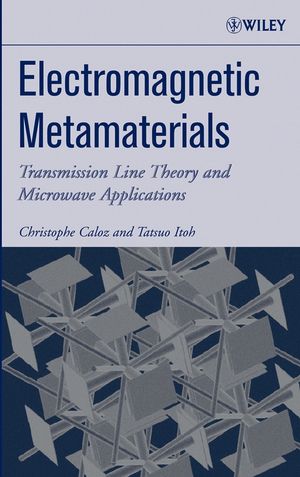Electromagnetic Metamaterials: Transmission Line Theory and Microwave ApplicationsISBN: 978-0-471-66985-2
Hardcover
376 pages
November 2005, Wiley-IEEE Press
 This is a Print-on-Demand title. It will be printed specifically to fill your order. Please allow an additional 10-15 days delivery time. The book is not returnable.
|
||||||
Acknowledgments.
Acronyms.
1 Introduction.
1.1 Definition of Metamaterials (MTMs) and Left-Handed (LH) MTMs.
1.2 Theoretical Speculation by Viktor Veselago.
1.3 Experimental Demonstration of Left-Handedness.
1.4 Further Numerical and Experimental Confirmations.
1.5 “Conventional” Backward Waves and Novelty of LH MTMs.
1.6 Terminology.
1.7 Transmission Line (TL) Approach.
1.8 Composite Right/Left-Handed (CRLH) MTMs.
1.9 MTMs and Photonic Band-Gap (PBG) Structures.
1.10 Historical “Germs” of MTMs.
References.
2 Fundamentals of LH MTMs.
2.1 Left-Handedness from Maxwell’s Equations.
2.2 Entropy Conditions in Dispersive Media.
2.3 Boundary Conditions.
2.4 Reversal of Doppler Effect.
2.5 Reversal of Vavilov- ˘ Cerenkov Radiation.
2.6 Reversal of Snell’s Law: Negative Refraction.
2.7 Focusing by a “Flat LH Lens”.
2.8 Fresnel Coefficients.
2.9 Reversal of Goos-H¨anchen Effect.
2.10 Reversal of Convergence and Divergence in Convex and Concave Lenses.
2.11 Subwavelength Diffraction.
References.
3 TLTheoryofMTMs.
3.1 Ideal Homogeneous CRLH TLs.
3.1.1 Fundamental TL Characteristics.
3.1.2 Equivalent MTM Constitutive Parameters.
3.1.3 Balanced and Unbalanced Resonances.
3.1.4 Lossy Case.
3.2 LC Network Implementation.
3.2.1 Principle.
3.2.2 Difference with Conventional Filters.
3.2.3 Transmission Matrix Analysis.
3.2.4 Input Impedance.
3.2.5 Cutoff Frequencies.
3.2.6 Analytical Dispersion Relation.
3.2.7 Bloch Impedance.
3.2.8 Effect of Finite Size in the Presence of Imperfect Matching.
3.3 Real Distributed 1D CRLH Structures.
3.3.1 General Design Guidelines.
3.3.2 Microstrip Implementation.
3.3.3 Parameters Extraction.
3.4 Experimental Transmission Characteristics.
3.5 Conversion from Transmission Line to Constitutive Parameters.
References.
4 Two-Dimensional MTMs.
4.1 Eigenvalue Problem.
4.1.1 General Matrix System.
4.1.2 CRLH Particularization.
4.1.3 Lattice Choice, Symmetry Points, Brillouin Zone, and 2D Dispersion Representations.
4.2 Driven Problem by the Transmission Matrix Method (TMM).
4.2.1 Principle of the TMM.
4.2.2 Scattering Parameters.
4.2.3 Voltage and Current Distributions.
4.2.4 Interest and Limitations of the TMM.
4.3 Transmission Line Matrix (TLM) Modeling Method.
4.3.1 TLM Modeling of the Unloaded TL Host Network.
4.3.2 TLM Modeling of the Loaded TL Host Network (CRLH).
4.3.3 Relationship between Material Properties and the TLM Model Parameters.
4.3.4 Suitability of the TLM Approach for MTMs.
4.4 Negative Refractive Index (NRI) Effects.
4.4.1 Negative Phase Velocity.
4.4.2 Negative Refraction.
4.4.3 Negative Focusing.
4.4.4 RH-LH Interface Surface Plasmons.
4.4.5 Reflectors with Unusual Properties.
4.5 Distributed 2D Structures.
4.5.1 Description of Possible Structures.
4.5.2 Dispersion and Propagation Characteristics.
4.5.3 Parameter Extraction.
4.5.4 Distributed Implementation of the NRI Slab.
References.
5 Guided-Wave Applications.
5.1 Dual-Band Components.
5.1.1 Dual-Band Property of CRLH TLs.
5.1.2 Quarter-Wavelength TL and Stubs.
5.1.3 Passive Component Examples: Quadrature Hybrid and Wilkinson Power Divider.
5.1.3.1 Quadrature Hybrid.
5.1.3.2 Wilkinson Power Divider.
5.1.4 Nonlinear Component Example: Quadrature Subharmonically Pumped Mixer.
5.2 Enhanced-Bandwidth Components.
5.2.1 Principle of Bandwidth Enhancement.
5.2.2 Rat-Race Coupler Example.
5.3 Super-compact Multilayer “Vertical” TL.
5.3.1 “Vertical” TL Architecture.
5.3.2 TL Performances.
5.3.3 Diplexer Example.
5.4 Tight Edge-Coupled Coupled-Line Couplers (CLCs).
5.4.1 Generalities on Coupled-Line Couplers.
5.4.1.1 TEM and Quasi-TEM Symmetric Coupled-Line Structures with Small Interspacing: Impedance Coupling (IC).
5.4.1.2 Non-TEM Symmetric Coupled-Line Structures with Relatively Large Spacing: Phase Coupling (PC).
5.4.1.3 Summary on Symmetric Coupled-Line Structures.
5.4.1.4 Asymmetric Coupled-Line Structures.
5.4.1.5 Advantages of MTM Couplers.
5.4.2 Symmetric Impedance Coupler.
5.4.3 Asymmetric Phase Coupler.
5.5 Negative and Zeroth-Order Resonator.
5.5.1 Principle.
5.5.2 LC Network Implementation.
5.5.3 Zeroth-Order Resonator Characteristics.
5.5.4 Circuit Theory Verification.
5.5.5 Microstrip Realization.
References.
6 Radiated-Wave Applications.
6.1 Fundamental Aspects of Leaky-Wave Structures.
6.1.1 Principle of Leakage Radiation.
6.1.2 Uniform and Periodic Leaky-Wave Structures.
6.1.2.1 Uniform LW Structures.
6.1.2.2 Periodic LW Structures.
6.1.3 Metamaterial Leaky-Wave Structures.
6.2 Backfire-to-Endfire (BE) Leaky-Wave (LW) Antenna.
6.3 Electronically Scanned BE LW Antenna.
6.3.1 Electronic Scanning Principle.
6.3.2 Electronic Beamwidth Control Principle.
6.3.3 Analysis of the Structure and Results.
6.4 Reflecto-Directive Systems.
6.4.1 Passive Retro-Directive Reflector.
6.4.2 Arbitrary-Angle Frequency Tuned Reflector.
6.4.3 Arbitrary-Angle Electronically Tuned Reflector.
6.5 Two-Dimensional Structures.
6.5.1 Two-Dimensional LW Radiation.
6.5.2 Conical-Beam Antenna.
6.5.3 Full-Space Scanning Antenna.
6.6 Zeroth Order Resonating Antenna.
6.7 Dual-Band CRLH-TL Resonating Ring Antenna.
6.8 Focusing Radiative “Meta-Interfaces”.
6.8.1 Heterodyne Phased Array.
6.8.2 Nonuniform Leaky-Wave Radiator.
References.
7 The Future of MTMs.
7.1 “Real-Artificial” Materials: the Challenge of Homogenization.
7.2 Quasi-Optical NRI Lenses and Devices.
7.3 Three-Dimensional Isotropic LH MTMs.
7.4 Optical MTMs.
7.5 “Magnetless” Magnetic MTMs.
7.6 Terahertz Magnetic MTMs.
7.7 Surface Plasmonic MTMs.
7.8 Antenna Radomes and Frequency Selective Surfaces.
7.9 Nonlinear MTMs.
7.10 Active MTMs.
7.11 Other Topics of Interest.
References.
Index.



